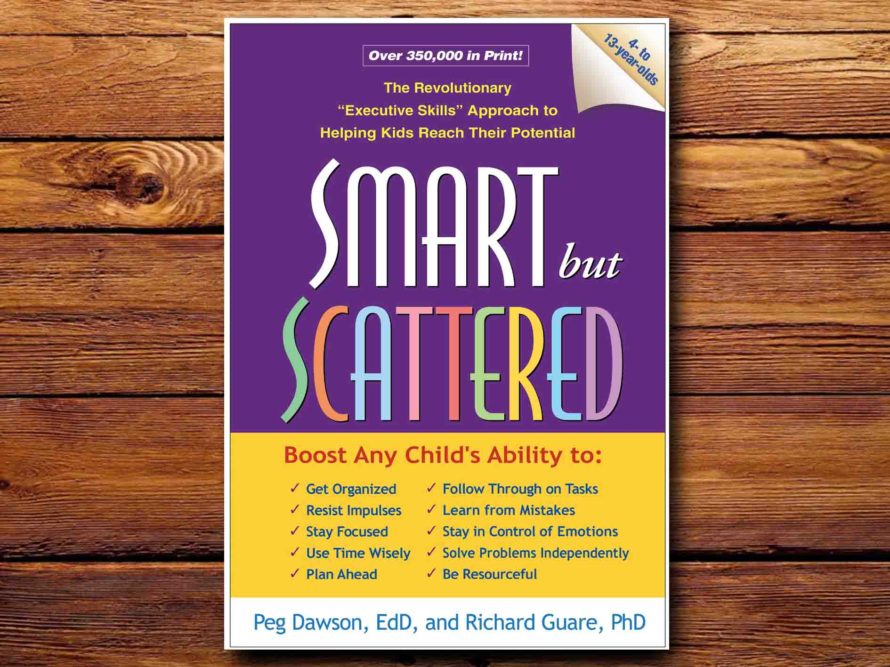I’m going to jump right to my conclusion and say that you should get this book. If you are the parent of a child with a learning disability, ADHD, ASD, or just a typical child whose messy room, homework refusal, or poor sportsmanship is causing tension in your home, the advice offered by Drs. Dawson and Guare will speak to you. The authors have a companion book for older children (Smart but Scattered Teens), but – full disclosure – I have not read it yet. I am confident, though, that it will have the same format: a healthy dose of child development and warehouse of practical advice. I have already recommended Smart but Scattered to colleagues, friends, and family members, and I have bought a copy of the parent book and a teacher version for my school, and now I am happy to recommend it to you.
Smart but Scattered is about managing executive skills weaknesses in children 4-13. Often, executive functions are described as the skills needed by an executive to run a company (e.g., organization, prioritizing tasks, monitoring progress, etc.). Dawson and Guare make it clear, though, that they are so much more wide-ranging than running a company; “Executive skills are the fundamental brain-based skills required to execute tasks” (p. 1) – any tasks. While playing hockey isn’t in itself an executive skill, keeping the rules in your working memory, controlling your temper when the referee gives you a penalty, and keeping your head in the game are. Executive skills fall into two basic categories: planning and directing activities; and regulating behaviour. Specifically, these skills include response inhibition, working memory, emotional control, sustained attention, task initiation, planning/prioritization, organization, time management, goal-directed persistence, flexibility, and metacognition (p. 15).
Part 1: What Makes Your Child Smart but Scattered?
The first chapter gives readers a background into the development of executive skills, starting with babies learning to wait for a short period at only 5 or 6 months old (response inhibition) to more complex skills like self-monitoring and self-evaluating your skills or behaviour, possibly in response to feedback from peers or adults (metacognition). Because executive skills are heavily reliant on frontal lobe functions which don’t finish developing until early adulthood, we can expect that children and teens will display immaturity in their executive skills profiles, but we can also expect that they will grow and develop along a fairly predictable trajectory. Understanding the continuum of executive skills development helps parents gauge where their own children are and know where they are heading.
Chapter 2 introduces four age-based surveys (preschool/kindergarten; grades 1-3; grades 4-5; grades 6-8) so that parents can assess their child’s executive skills strengths and weaknesses. Then chapter 3 encourages parents to do their own questionnaire to understand their own executive skills profile. If a child’s and parent’s profile are very different, there may be conflict due to their inability to understand the other person’s experience. For example, a disorganized child may have a chronically messy room and fail to understand why their inflexible parent cares so much. On the other hand, if the parent and child have the same weaknesses, they may need extra support to put a workable plan in place to improve both of their executive skills.
The last chapter in this section reminds readers that children need to be faced with challenges and obstacles in order to develop competence and independence, but these tasks need to be appropriate to the child and their executive skill profile. Dawson and Guare have some things to keep in mind:
- Pay attention to the child’s behavioural reaction to the task;
- Consider that task avoidance might mean a child finds that task too difficult;
- Figure out which executive skills are required for the task;
- Figure out whether the environment (anything external to the child) is making the task more difficult than it needs to be;
- Consider inconsistency as a possible sign of executive skill weakness in that area;
- With inconsistency, try to figure out which conditions lead to successful results; and
- Consider lack of confidence as a possible cause for poor performance.
Part 2: Laying a Foundation That Can Help
This section helps parents begin to develop plans for improving their child’s executive skills. After an introduction to the three basic elements of a plan, there is one chapter dedicated to each of them. First, change the environment. Consider the external factors that impact your child’s ability to execute a task. For example, you may need to define a specific physical space, reduce distractions, provide structure, or change the social environment of the activity. Then, think about the nature of the task such as the time required to complete it and the schedule for doing so, opportunities for breaks, the complexity of the instructions, and the innate interest of the task for the child. Lastly, how do the adults interact with the child before, during, and after the task?
The next chapter is about direct teaching of the missing skills. Changing the environment to match the child is important, but eventually, the child also needs to make changes in order to be successful in a wide variety of settings and circumstances. This chapter focuses on using verbal scaffolding, games, and real-word activities to teach the skills informally. Then a six-step plan is presented for how to teach executive skills intentionally and more formally:
- Identify the problem behaviour;
- Set a goal;
- Outline the steps required;
- Turn the steps into a list, checklist, or short set of rules;
- Supervise the child in following the procedure; and
- Fade the supervision.
The last chapter in this section is about setting up motivation for your child to improve their executive skills. It covers the generous use of praise, rewards for task completion, formal incentive programs, and behaviour contracts. There are samples of incentive programs and behaviour plans provided, as well as blank forms to be completed by you.
Part 3: Putting It All Together
This is where the real magic starts to happen. After a chapter with advice and planning sheets for designing your own plans of action, chapter 10 provides 20 ready-made plans for common problems encountered at home with suggestions for modifications based on your child’s age and developmental level. The plans provided are as follows: getting ready in the morning, bedroom cleaning, putting belongs away, completing chores, maintaining a practice schedule, bedtime, desk cleaning, homework, managing open-ended tasks, organizing long-term projects, writing a paper, studying for tests, learning to manage tasks that take a lot of effort, organizing notebooks/homework, controlling your temper, controlling impulsive behaviour, managing anxiety, handling changes in plans, learning to not cry over little things, and learning to solve problems. In addition to the plans, the chapter has ready-made checklists and tracking documents to measure your child’s success with the goals (pp. 130-186).
In case you didn’t find the right skills fully planned out in chapter 10, the next 11 chapters take each executive skill one by one, give a brief outline of expected development, provide another short checklist of embedded skills/tasks, and then provide a few pages of specific strategies for developing that executive skill.
The final few chapters in the book deal with what to do if you need more support. The authors have provided resources and suggestions about when to seek professional help, advice for working with schools, and a preview of what the teenage years will bring.
There are so many ready-to-use suggestions in this book that any parent could pick it up and be able to start a plan for change that day. If you’re having trouble managing routines at home or you can just identify struggles your child experiences, Smart but Scattered can point you in the right direction and get your child started on the road to greater independence and success.

